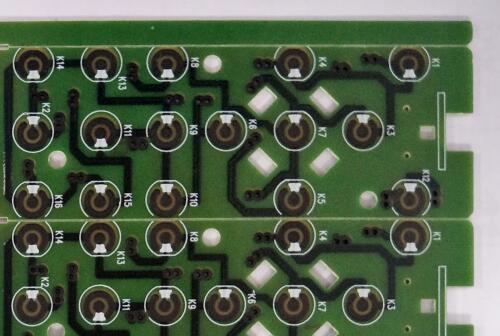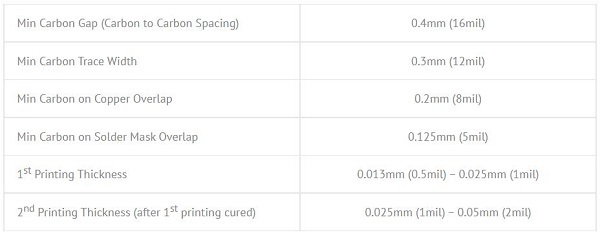Categorie
Conductive Carbon Ink
Conductive Carbon Ink PCB
Carbon ink PCB, also called carbon conductive PCB, are circuit boards with carbon ink applied onto the copper pad, replacing some of the more common solder plating such as Electroless Nickel Immersion Gold (ENIG) or Hot Air Solder Leveling – Lead Free (HASL).
The carbon serves as a conductor to connect two traces on PCB boards, and a resistor between the traces or traces and components. The key factor in carbon ink PCB boards production is to control the printing, baking and resistance control. The carbon ink can be printed onto flexible circuit, rigid-flex board and rigid circuit boards, such as polyimide, polyester, FR-4, FR-5 and PTFE laminates. Carbon ink can offer resolutions as fine as 100μm trace width and spacing.

Firgure-Conductive carbon ink PCB board
Two Main Applications
*Printed Carbon Resistors: PCR serves as an alternative for applications requiring the duplication of the desired function on a printed board or designated substrate. Carbon ink printing will apply for any combination of fixed resistor or potentiometer tracks in virtually any size, shape or form to a flat surface such as a PCB.
*Carbon Contacts: Carbon contacts or patterns are printed with a conductive carbon ink, which can be used for keyboard contacts, LCD contacts, jumpers and etc. PCB contacts can be gold plated or carbon screen printed. While, gold plated PCB is more expensive than carbon ink printed PCB. As same as hard gold on PCB board, carbon ink creates a protective contact surface for touch-key contacts.
Key Factors for Manufacturing High Quality Carbon Ink PCB
*Correct sheet resistance carbon ink selection. (Sheet resistance unit is ohm/□, or Ω/□.)
*Screen printing thickness control.
*Carbon ink baking temperature and time control.
*Resistance tolerance control.
Common Uses of Carbon Ink Printed Circuit Board
Carbon Ink PCBs are widely used for printed circuit boards deployed in the following applications:
1.RF Shielding
2.Keypad
3.Keyboard
4.Remote Controller
5.Automotive Vehicles
6.Industrial Engine Control
7.Welding Equipment
One particular area where Carbon Ink PCBs excel at is the application of rubber keypad, commonly found in television remote controllers, garage door controllers, etc. A typical conductive rubber keypad involves creating angled webbing around a switch center. When the switch is pressed, the webbing deforms and produces a tactile response. As soon as the switch is no longer under pressure, the webbing returns to its neutral position.
The carbon tactile key comes into play when making electronic switches, as a carbon pill is placed at the switch center’s base. If you have ever taken apart (or broken) a TV remote controller, you may notice on the printed circuit boards, under each rubber that you used to press, is a little circular dot that can be pressed down ever so slightly. This carbon tactile key contacts the PCB when the web is pressed; a rather simple and ingenious solution that is both durable and cost-effective.
Carbon Ink Spacing, Overlaps & Thickness
Considering of the tolerance, carbon ink leakage and other factors, carbon PCB design should follow below parameters.

If requiring thicker carbon ink thickness more than 0.025mm (1mil), we need to print the carbon ink twice. But the second carbon printed shapes should be smaller than that of the first, and the MI engineer needs to write two sets of tools.
Carbon Ink Printing Process
The manufacturing process is somewhat different from standard manufacturing process, but similar to silver ink PCB manufacturing process.
1.The operator must wear gloves
2.The equipment must be clean, the surface shall not have dust, garbage and other debris.
3.Screen-printing speed and back to the ink speed suction pressure control in the best range upon the printing effect as a test.
4.Screen stencil, scraper, carbon oil specific requirements in accordance with the requirements of MI engineer.
5.Carbon ink must be mixing evenly before use, with a viscometer to detect the viscosity within the required range, the ink needs timely closure after the use.
6.Before printing, all PCB boards must be cleaned plate grease, oxide and other pollutants, all carbon plate must be confirmed by the QA before the official production.
7.Carbon PCB drying temperature is 150oC at 45 minutes. Carbon ink hole drying temperature is 150oC at 20 minutes.
8.After the release form oven, the operator should inform the QA to check the carbon resistance and do the adhesion test.
9.Each carbon ink screen version uses max 2,500 printing times, and must be returned to the network room re-drying the new version when up to 2,500 printing times.
1users like this.



